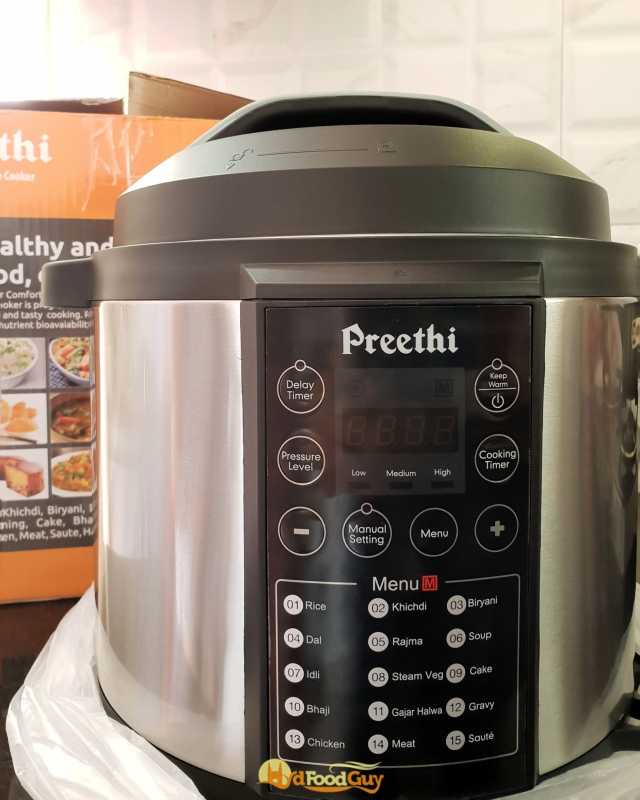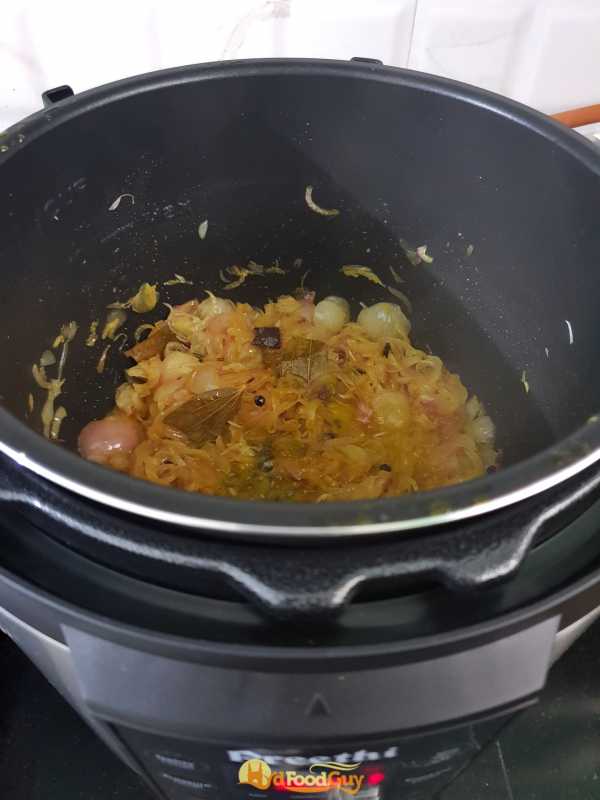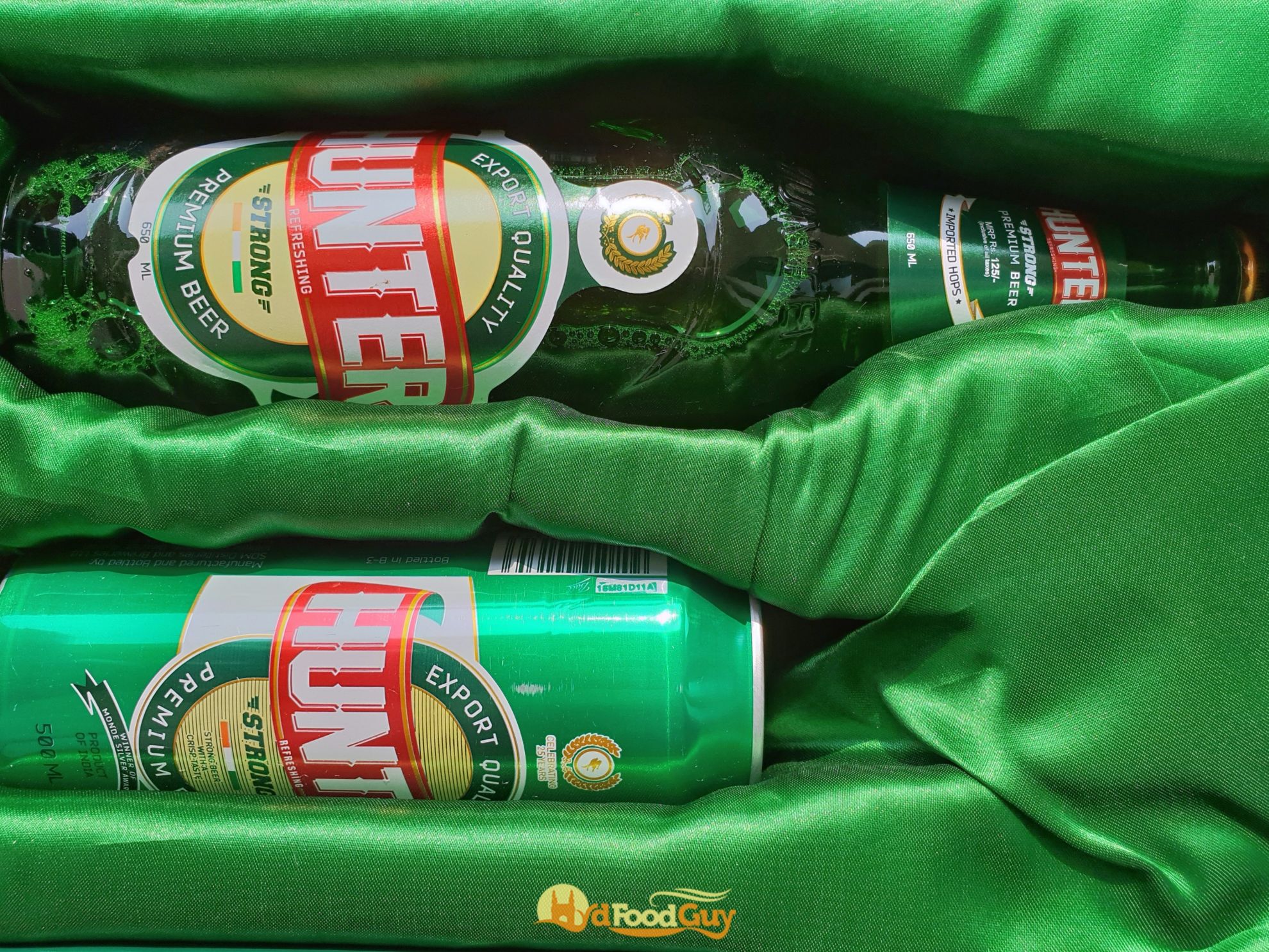I’ve always been intrigued by the pressure cookers on Masterchef Australia. They look cool and gets the job done without any of the typical huffing and puffing of the typical pressure cooker. So, when Preethi offered to send an Electric Pressure Cooker my way for a review, I immediately agreed.
Overview of Preethi Touch Electric Pressure Cooker
The model I was sent (Preethi Touch EPC005) is a 6-litre variant with touch-sensitive keypads. There’s a slightly smaller (5 litre) variant of Preethi Touch, as well as a variant called Preethi Twist that is operated by a knob. The entire unit is fairly bulky and weighs in excess of five and a half kilos. However, you don’t need to move the entire unit as both the lid and the cooking vessel are both removable. The light-weight cooking pan is made of aluminium and features a non-stick coating. The package also includes a measuring cup, a flat spatula, and a serving spoon.
Cooking with Preethi Touch Electric Pressure Cooker
I began my experimentation with the Preethi Touch cautiously – trying out simple fare like Rice and Dal before moving on to the more elaborate curries. The booklet that ships with the cooker include a measuring cup and the volume of water required is provided in the accompanying booklet. I found these measurements to be quite accurate and ended up perfectly cooked rice and dal at first attempt itself. The cooking process is quite simple. There are 15 presets available – tap on the menu button and then use the plus (+) and minus (-) buttons to navigate through the list. Once you’re at your desired spot, pause for a few seconds – the cooker will beep thrice and begin cooking. There are two phases to the cooking. The first few minutes of the cook are used to heat the water and build up pressure inside the vessel. Once the desired pressure level has been attained, the countdown timer starts. You’ll get another set of beeps when the clock counts down to zero and the cooking process finishes. Once the cooking is complete, the cooker automatically switches to Keep Warm mode that can keep food warm for up to 4 hours post-cooking. Once you’re ready to open the cooker, you’ve to first set the pressure valve to release mode to expel steam and then twist the handle to release the lid.
When cooking simple curries, I often use the cooker for both sauteing and pressure cooking. For the homely Chicken Curry, I wanted to try something similar with the Preethi Touch. One of the fifteen present modes is Saute. I added three tablespoons of mustard oil and set the cooker to Saute mode. After about 3 minutes, once the oil was hot enough, I added whole garam masala and bay leaves. After another minute or so, I added the onions that I had thinly sliced using my food processor. Finally, after another five minutes, I added two teaspoons of ginger garlic paste. The Electric cooker doesn’t get as hot as a conventional stove-top pressure cooker. After adding the ginger-garlic paste, I had to cook for another ten minutes. The total saute time was around twenty minutes, which is a bit longer than what you’d need on a gas oven.
The second phase of cooking the Chicken Curry involved adding about one and a half kilo of pre-marinated chicken along with water. I closed the lid and set the cooker to Preset 13, which is for cooking Chicken. Once again the pressure followed the same routine – it took about five minutes to build pressure and then cooked for 15 minutes. I got an almost perfect Chicken Curry. Why almost? The meat was cooked to perfection; however, due to an oversight on my part, I had ended up with a lot more gravy than I had expected.
Advantages of Preethi Touch Electric Pressure Cooker
There are a few fundamental differences between the Preethi Touch and a conventional stove-top cooker. One of the biggest is that Preethi Touch doesn’t expel steam. The conventional pressure cookers use a weighted lid to control the pressure inside. Once the pressure threshold is reached, the steam lifts up the lid and excess steam is expelled to reduce the internal pressure. It’s an entirely mechanical process. Preethi Touch instead uses pressure sensors to measure the pressure; once the target pressure level is achieved, it stops forming more steam by reducing the heat. This had several tangible benefits. The most obvious ones are that Preethi Touch operates silently and can be used in tighter spaces because it isn’t expelling tons of steam. Another benefit is that you need significantly less water. I hadn’t factored this in and ended up with excess water during my first attempt at cooking a curry. I was able to fix that by turning on the saute mode for another 10 minutes and letting the gravy thicken. Pressure cooked food will never be able to compete with slow-cooked food, but because everything remains sealed inside till the very end of the cook, recipes executed using Preethi Touch feel more aromatic and flavourful. Because the water required is less, you can also cook a slightly larger quantity in this than a traditional pressure cooker of comparable capacity.
The cooking vessel in the Preethi Touch is a removable aluminium container with non-stick coating. This makes cleaning a breeze. I’ll need to use it for a few months to see how durable the coating is, but it’s definitely a welcome addition. It is not heavy bottomed, but the aluminium body does a good job at distributing heat evenly, while the non-stick coating prevents food from getting stuck to the base. It’s easy to burn onions while sauteing on a pan if you are not careful. However, the Preethi Touch allows you to be much more hands off. The onions took a lot longer to get cooked, but the combination of non-stick coating, uniform heat distribution, and a controlled and mild heat allowed them to get browned evenly without requiring constant stirring. The saute mode is capable enough to prep the ingredients prior to pressure cooking, but don’t expect it to fully replace your induction or gas powered kadhai.
The Preethi Touch also has a mode for steaming Idlis. Unlike other dishes, Idli needs to be cooked with the pressure release valve set to the release position. However, I didn’t try this as an Idli stand isn’t included and I didn’t have a stand that fits inside this cooker. Besides the fifteen preset modes, there’s also a manual mode that allows you to set the desired pressure level and cook time.
Timers are an absolute godsend for the forgetful. It’s one of the most obvious and seemingly small things that makes everything a lot easier. I just love the fact that I no longer have to be worried about miscounting the whistles. Once the food is cooked, the cooker automatically switches to a Keep Warm mode that keeps the contents warm until you’re ready to serve. If you aren’t a fan of the uneven and rapid heating in a microwave, you can also use this function to gently and evenly heat up frozen food.
There’s also a delay timer that allows you to defer the cooking by 30 minutes to 8 hours. So you can prep the ingredients and leave for office. Piping hot, freshly cooked curry or rice will be ready for you to savour when you come back home.
Verdict
Preethi Touch costs more than twice as much as a standard pressure cooker; however, it also does a whole lot more than a traditional pressure cooker. This electric pressure cooker doesn’t just look cool. It’s a practical, every-day device that upgrades the age-old pressure cooker in meaningful ways. If you’re looking to buy a new pressure cooker, this is definitely an upgrade worth considering for your kitchen.











